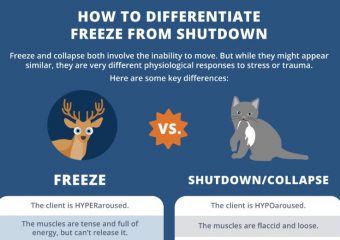Dissociation can be tricky to spot. On top of that, it can look awfully similar to freeze or shutdown. And to complicate things further, a patient might dissociate when they’re in either one of those trauma responses. But being able to detect when a client is dissociating is critical for providing effective treatment. So in […]
What’s Happening in the Nervous System of Patients Who “Please and Appease” (or Fawn) in Response to Trauma? With Stephen Porges, PhD
You’ve probably heard of fight, flight, and even the freeze response to trauma. But there are some newer defense responses – ones that experts have only recently begun to name and understand – that are critical to our clinical work. One of those defense responses is “please and appease.” You may have also heard expert […]
Working with Emotional Distress – with Janina Fisher, PhD
When it comes to treating trauma, we’re often working with clients who have a low tolerance for distress. And when faced with traumatic memories or difficult emotions, they may respond by slipping into a state of hypoarousal to defend against the pain. So in the video below, Janina Fisher, PhD shares how she helps hypoaroused […]
[Infographic] How to Differentiate Between the Freeze and Shutdown Trauma Responses
The freeze and shutdown responses to trauma can resemble each other . . . . . . but they are very different in terms of what’s happening in your client’s brain, body, and nervous system. And that means they require different grounding strategies as well. In this infographic, we lay out some key cues to […]
How to Help a Client Come Back from Freezing in a Session
Working through trauma can trigger many perceived threats for our clients. They might start to breath rapidly and find it hard to hold still, or perhaps they start to freeze up during the session. So what are some practical ways to calm the nervous system and keep a client grounded – especially when they begin […]




